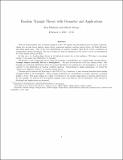Random Triangle Theory with Geometry and Applications
Author(s)
Edelman, Alan; Strang, Gilbert
Download10208_2015_9250_ReferencePDF.pdf (1.346Mb)
OPEN_ACCESS_POLICY
Open Access Policy
Creative Commons Attribution-Noncommercial-Share Alike
Terms of use
Metadata
Show full item recordAbstract
What is the probability that a random triangle is acute? We explore this old question from a modern viewpoint, taking into account linear algebra, shape theory, numerical analysis, random matrix theory, the Hopf fibration, and much more. One of the best distributions of random triangles takes all six vertex coordinates as independent standard Gaussians. Six can be reduced to four by translation of the center to (0,0) or reformulation as a 2 × 2 random matrix problem. In this note, we develop shape theory in its historical context for a wide audience. We hope to encourage others to look again (and differently) at triangles. We provide a new constructive proof, using the geometry of parallelians, of a central result of shape theory: triangle shapes naturally fall on a hemisphere. We give several proofs of the key random result: that triangles are uniformly distributed when the normal distribution is transferred to the hemisphere. A new proof connects to the distribution of random condition numbers. Generalizing to higher dimensions, we obtain the “square root ellipticity statistic” of random matrix theory. Another proof connects the Hopf map to the SVD of 2 × 2 matrices. A new theorem describes three similar triangles hidden in the hemisphere. Many triangle properties are reformulated as matrix theorems, providing insight into both. This paper argues for a shift of viewpoint to the modern approaches of random matrix theory. As one example, we propose that the smallest singular value is an effective test for uniformity. New software is developed, and applications are proposed.
Date issued
2015-03Department
Massachusetts Institute of Technology. Department of MathematicsJournal
Foundations of Computational Mathematics
Publisher
Springer US
Citation
Edelman, Alan, and Gilbert Strang. "Random Triangle Theory with Geometry and Applications." Foundations of Computational Mathematics 15:3 (2015), pp.681-713.
Version: Author's final manuscript
ISSN
1615-3375
1615-3383